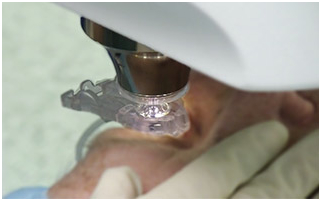 A recent study titled “Identification of Patients at High Risk for Postoperative Complications in Cataract Surgery” recently published online in Healio – Opthalmology Education lab provided insight into the current state of treatments to address inflammation after cataract surgery.
A recent study titled “Identification of Patients at High Risk for Postoperative Complications in Cataract Surgery” recently published online in Healio – Opthalmology Education lab provided insight into the current state of treatments to address inflammation after cataract surgery.
Due to the high prevalence of cataracts, the rates of cataract surgery have significantly increased and account for the third most common outpatient surgery performed in the United States, with estimations referring more than 3 million surgeries per year.
The use of technology intraocular lenses (IOLs) has contributed to more customized patient selection and better treatment outcomes. Other technologies such as femtosecond laser technology, biometry and keratometry, and the use of optical coherence tomography (OCT) before and after surgery, have all provided good cataract surgery outcomes. However, postoperative inflammation continues to affect patients after these procedures.
Ocular Inflammation peaks within a few days after surgery and is associated with breakdown of the blood-aqueous barrier, allowing cells and proteins to infiltrate the anterior chamber, potentially leading to the development of cystoid macular edema (CME) and its adverse effects on visual acuity. Inflammation usually occurs due to prostaglandin formation. The arachidonic acid metabolism pathway produces prostaglandins and is activated with the initiation of surgical trauma, with arachidonic acid metabolized in both cyclooxygenase pathways (COX-1 and COX-2) resulting in eicosanoids that include, in addition to prostaglandins, prostacyclin and thromboxane.
Many of the pleiotropic effects of prostaglandins contribute to their role in postsurgical inflammation and pain. The vascular permeability, vasodilation and disruption of the ocular-blood barriers that can be produced by prostaglandins may contribute to inflammatory cells and protein infiltration in the aqueous humor, hyperemia, erythema and corneal and/or retinal edema.
In the opinion article, Terry Kim, MD, presents a summary of the current therapeutics options available for clinicians:
Optical Coherence Tomography (OCT)
OCT provides a high-resolution image of macular anatomy and can measure subtle postoperative retinal thickening, with > 95% sensitivity and specificity for the diagnosis of cystoid macular edema (CME), becoming a useful approach for preoperative assessment for high-risk patients. OCT has become the typical method for epiretinal membrane (ERM) diagnosis, and OCT-based preoperative evaluations are less susceptible to false negatives that can occur with biomicroscopy when the cataract obscures the ocular fundus.
Anti-inflammatory and Pain Treatments
Anti-inflammatory drugs should be given before surgery. The production of prostaglandins should be prevented, as agents that can neutralize their action following their release are not available.
Corticosteroids and non-steroidal anti-inflammatory drugs (NSAIDs) provide active inhibition in the inflammatory cascade; however, these agents do so at different locations in the pathway. Steroids act primarily on phospholipase A2, inhibiting the release of arachidonic acid, while NSAIDs act primarily at the level of the cyclooxygenases, minimizing prostaglandin production through the inhibition of these enzymes. Evidence suggests that by acting at different locations in the inflammatory cascade, NSAIDs may work synergistically with steroids to minimize inflammation following ocular surgery.
Several anti-inflammatory treatment options are currently available. New compounds and formulations are being developed, and the FDA approved 3 new topical anti-inflammatory therapeutic products in 2013.
Corticosteroids
Corticosteroids have long been the choice of treatment for many inflammatory conditions, including those affecting the eyes, as their effects can limit pros-taglandin production, down-regulating expression of vascular endothelial growth factor and platelet-derived growth factor and inhibiting leukocyte function and cytokine secretion through a feedback mechanism.
NSAIDs
The most common outcomes of NSAID use include pupillary dilation maintenance and prevention of intraoperative miosis, managing postoperative inflammation, reducing postoperative pain and discomfort, and preventing and treating CME.
CME and NSAIDs
CME is the most frequent cause of visual decline following uncomplicated cataract surgery and is related to the breakdown of the blood-retina barrier that is mediated by prostaglandins. Factors that increase the risk of CME involve the clinical status of the patient and specific surgery characteristics and complications.
The efficacy of NSAIDs used in combination with corticosteroids to reduce CME incidence was demonstrated in an important prospective study of 60 patients undergoing cataract surgery. Results from the study showed that NSAID-plus-steroid group had developed CME, compared with 12% in the postoperative steroid-only group.
Based on the evidence provided, Dr. Terry Kim concluded that the most effective way to address inflammation is to avert it. The author notes that clinicians should be able to anticipate patients’ inflammation and pre-treat it with an NSAID. He also mentioned that surgical outcomes can be improved if high-risk patients are identified and monitored, providing them with counseling of potential complications.


